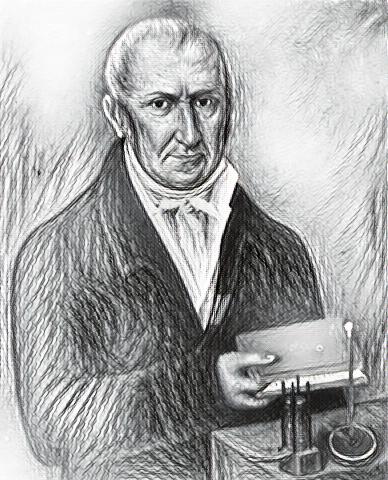Alessandro Volta
Italian physicist Alessandro Volta made a number of discoveries in the late 18th and early 19th century critical to the then all-new and growing field of electricity. His development of the first electric pile preceded the modern battery and this, among many other accomplishments, led fellow scientists to immortalize him by naming the unit for electromagnetic force, the volt, in his honor.
Born Alessandro Giuseppe Antonio Anastasio Volta on February 18, 1745, in Como, Italy, Volta was encouraged by his family to study law and by his teachers to enter the priesthood, but he became fascinated with electricity as a teenager and by 14 years of age had decided to pursue his passion for physics.
He left school early and did not pursue university studies, but Volta did begin working and corresponding with scientists conducting research in the electricity arena including Abbott Nollet in Paris and Giambatista Beccaria in Turin. In 1769 he wrote his first paper, a theory on the forces of “attraction of electrical fire.”
He began teaching in a local school in Como in 1774 while continuing his experiments with electricity and made several notable accomplishments within that decade including improving and popularizing the perpetual electrophorus, an object that produces charges of static electricity and is able to transfer charge to other objects; and isolating methane gas, which he did after observing bubbles rise to the surface of the marsh in swamps. He also experimented with causing interacting gases to explode inside a closed chamber, producing an experimental device known as the Voltaic pistol; this has been cited as a predecessor to several later technologies including the telegraph and the internal combustion engine.
During these years, Volta’s reputation began to grow quickly throughout academic circles in Europe. In 1778 he accepted a post as professor of physics at the University of Pavia where he began teaching experimental physics in 1779 and where he would continue to do so for almost 40 years. In 1780 he set out on a journey to France, Switzerland, Germany, Belgium, Holland and England, spending a year meeting and working with fellow scientists. In 1785 he was elected Rector of the University at Pavia. In 1794 he married and would have three sons.
Though he had already achieved renown in his field, Volta’s most famous accomplishment did not come until 1800, when he revealed to the world the Voltaic Pile. At that time, though electricity had been discovered in the middle of the previous century and was being used in some fields, like medicine, on a limited basis, widespread use of electricity was still impossible. Until then, no one had figured out a way to provide a source of continuous current.
In 1780, Volta had become engaged in a debate with Italian physician and scientist Luigi Galvani that would inspire his development of a device, which would solve that problem and seal his place in history. Galvani had been experimenting with dissected frogs’ legs, still attached to their spinal cords and hung on brass or iron hooks. He noted that when touched with a piece of another metal the frog legs would twitch; he believed he had discovered a new form of electricity, generated by those legs. He called this “animal electricity.”
Volta refuted this theory and insisted that the animals’ legs were not producing the electricity, only reacting to it. He believed that the metals used in Galvani’s experiments were generating the current and set out to prove Galvani wrong. The argument would divide the scientific community in Italy for years to come.
Volta unveiled on March 20, 1800, through a letter to the president of the Royal Society of London, the first-ever electric pile. He built the device in an effort to show that generating electrical current did not require any animal tissue. Rather, his model included a stack of alternating silver and zinc wafers, with pieces of brine-soaked cloth in between. When a wire was connected to both ends of the pile at once, a current flowed. Different types of metal affected the volume of current produced, and adding more wafers could increase the intensity. This, essentially, was the world’s first battery. It was an instant success and helped lead to further research and development in electrochemistry, electromagnetism, and practical applications for electricity.
Impressed by his work, Napoleon granted Volta a pension in 1805 and appointed him Cavalier of the Legion of Honor. He named Volta a count in 1810. Volta held several political offices in Italy from 1801 to 1812 and stopped teaching in 1813.
The Emperor of Austria named him professor of philosophy at Padua in 1815 and in 1816 his works were published in five volumes in Florence. He retired to the family estate in Camnago, near Como, in 1819 and led a relatively quiet and private life until his death on March 5, 1827. The volt was named in his honor in 1881.


